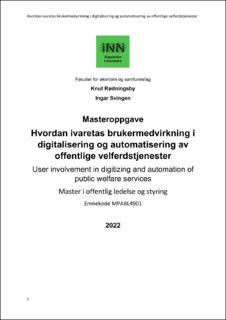Hvordan ivaretas brukermedvirkning i digitalisering og automatisering av offentlige velferdstjenester
Master thesis
Permanent lenke
https://hdl.handle.net/11250/3064696Utgivelsesdato
2022Metadata
Vis full innførselSamlinger
Sammendrag
Brukermedvirkning er en viktig del av den offentlige forvaltingen i Norge generelt, og ersentralt i å opprettholde legitimiteten som velferdstjenester er avhengig av å ha. Denneoppgaven setter søkelys på hvordan brukermedvirkning ivaretas i utforming av det digitalevelferdstilbudet, altså hvordan involveres brukeren i prosessen med å utvikle eller forbedre dedigitale tjenestene.NAV har i stor grad digitalisert sine velferdstjenester som en del av og i forlengelsen av NAVreformen, og har gjennom COVID-19 pandemien lansert flere nye digitale velferdstjenesterpå kort tid. Gjennom en case studie av hvordan NAV ivaretar brukermedvirkning når deutvikler og forbedrer de digitale tjenestene forsøker oppgaven å drøfte hvordan dette hengersammen med de overordnede føringene for brukermedvirkning for offentlige etater genereltog for NAV spesielt.Undersøkelsen er gjennomført ved å intervjue ansatte i NAV IT og gjennom en tematiskanalyse av disse intervjuene kategorisere og aggregere funn knyttet til hvordanbrukermedvirkning ivaretas og drøftet dette mot relevant teori og støtteinformasjon.Oppgaven viser at når velferdstjenestene digitaliseres ved bruk av moderne metodikk forprogramvare utvikling så kan det være nødvendig å tenke nytt rundt hva som er aktivt ogpassiv brukermedvirkning, hva som er reaktiv og proaktiv involvering og hva som forstås somarena for brukermedvirkning. Funnene i oppgaven viser også viktigheten av å bygge enkultur for brukermedvirkning i den delen av organisasjonen som faktisk skal lage de digitaletjenestene samt gir indikasjoner på muligheten for en mer brukerdrevet forvaltning hvisfagutvikling og utvikling av de digitale tjenestene kobles sammen og utføres med høy grad avbrukerinvolvering og brukerfokus. The study shows that when modern methods for developing software are applied this can risereason for to rethink the mening of active or passive user interaction, reacting and proactiveinvolvement and what an arena for user involment look like. The findings also shows theimportanse of creating a culture for user involvement in the part for the organisation actuallydeveloping the digital services and gives indication of creating an more user driven publicgovernance if the development of the profession is thightly coupeled with the development ofthe digital services and performed with a high degree of inser interaction and high degree ofuser attention. User interaction is an important part of the governance of the public services inNorway in general and is fundamental in upholding the legitimization that the welfareservices are depending on. This paper addresses how user interaction are carried out in theprocess of creating and improving the digital welfare services.NAV have digitalized many of their welfare services as a part of a NAV reform and in thefollowing digital projects. NAV has during the COVID-19 pandemic launched several newdigital services in a short period of time. Through a case study of how NAV ensures userinteraction in the development and improvement of their digital services this paper attempts todiscuss how this relates to the overall guide for user interaction for public services in generaland for NAV in particular.The study has been performed by conducting a series of interviews with employees involvedin the developing of digital services. Findings from the interview has undergone a thematicanalysis with grouping and aggregation and are discussed against relevant theory and supportinformation.The study shows that when modern methods for developing software are applied this can risereason to rethink the meaning of active or passive user interaction, reactive and proactiveinvolvement and what an arena for user involvement looks like. The findings also shows theimportance of creating a culture for user involvement in the part for the organisationdeveloping the digital services and gives indication of creating a more user driven publicgovernance if the development of the profession is tightly coupled with the development ofthe digital services and performed with a high degree of user interaction and high degree ofuser attention.
